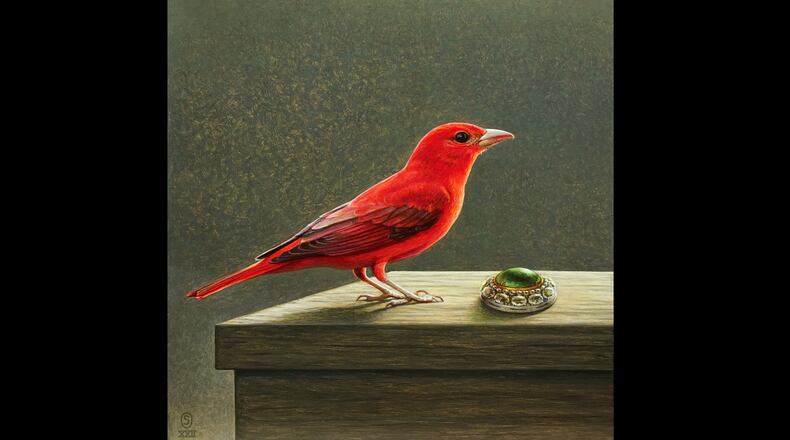Stephen O’Donnell’s small paintings of birds and animals, at TEW Galleries through March 26, combine meticulous brushwork with careful observation and faintly unsettling content that makes these poetically tinged works much more than simple exercises in realism and Renaissance technique.
A few pieces, most notably “Youth (mule deer),” are fairly straightforward representation, though even here O’Donnell holds to his declaration: “I’m not an artist who paints the world around me; the goal isn’t to paint a tree that looks like a tree, but one that looks like a painting of a tree.”
The closeup portraiture of “Focus (peregrine falcon)” and “Salvage (little blue heron)” may render details of pose and feathers in a manner likely to satisfy the most ornithologically minded of viewers, but the impulse behind them is art-historical.
Credit: Courtesy of TEW Galleries
Credit: Courtesy of TEW Galleries
Most of the dozen paintings in this exhibition, however, feature birds and animals holding or contemplating pieces of jewelry. Sometimes there is a clear aesthetic correlation, as when the blue jewel included in a pearl necklace echoes the color of the bird that perches questioningly above it, in a work aptly titled “Scrutiny (eastern bluebird).” Sometimes this type of connection takes the form of a visual joke, such as the rear view of an eastern cottontail that plainly parallels the shape and color of the Fabergé egg placed next to the creature.
Other juxtapositions have a tone of poignancy, notably in “Gift (tufted capuchin),” where the little primate clutches a strand of pearls while gazing into space with an indecipherable but emotionally compelling facial expression. One work, “Dash (boat-tailed grackle),” alludes to the bird’s reputation for making off with shiny objects, as it holds in its beak the chain of a necklace holding a single drop-mounted pearl. “Pinch (cherry headed conure)” features a spectacularly colored parrot apparently engaged in the same activity.
Credit: Courtesy of TEW Galleries
Credit: Courtesy of TEW Galleries
A third of the works in the show, however, simply place pieces of jewelry adjacent to the creature being depicted, sometimes with a less obvious relationship than the one in “Competition (summer tanager),” in which the gorgeously vivid color of the bird holds its own against the different beauty of an ornately patterned brooch resting next to it on the tabletop that holds both of them.
There is a strong temptation to look for allegories in these paintings like those that some art historians discern in iconic works of the Renaissance.
But O’Donnell claims nothing but a formalist fascination with the look of jewels placed next to jewel-like examples of natural beauty, which he renders in such precise detail that in some pieces the texture of fur or feathers is almost hallucinatorily exact.
Credit: Courtesy of TEW Galleries
Credit: Courtesy of TEW Galleries
His use of the smallest brushes available produces results that are, indeed, not so much portrayals of a creature as portrayals of a style of painting. Nature rarely approaches this level of elegant regularity in its actual examples.
It should be mentioned (because the gallery mentions it) that O’Donnell is better known for self-portraits expressing his non-binary identity but they are a distinctly separate enterprise from the exquisitely intimate little paintings in this exhibition. There’s a comprehensive discussion of the topic on O’Donnell’s website (stephenodonnellartist.com), or Timothy Tew’s video interview with the artist on the gallery’s website. The latter also includes a detailed discussion of his painting methods.
Jerry Cullum’s reviews and essays have appeared in Art Papers magazine, Raw Vision, Art in America, ARTnews, International Journal of African-American Art and many other popular and scholarly journals. In 2020 he was awarded the Rabkin Prize for his outstanding contribution to arts journalism.
Credit: ArtsATL
Credit: ArtsATL
MEET OUR PARTNER
ArtsATL (www.artsatl.org), is a nonprofit organization that plays a critical role in educating and informing audiences about metro Atlanta’s arts and culture. Founded in 2009, ArtsATL’s goal is to help build a sustainable arts community contributing to the economic and cultural health of the city.
If you have any questions about this partnership or others, please contact Senior Manager of Partnerships Nicole Williams at nicole.williams@ajc.com.
About the Author
The Latest
Featured






